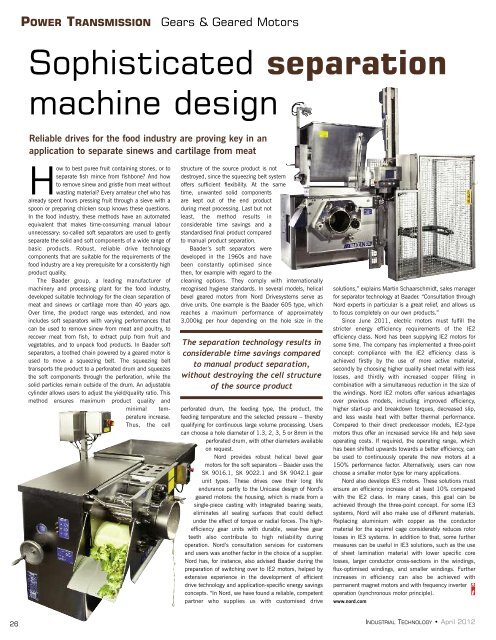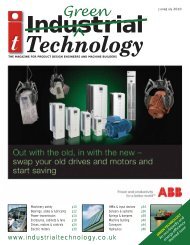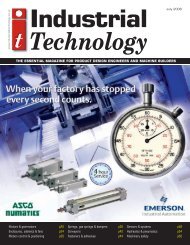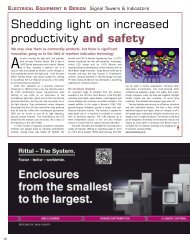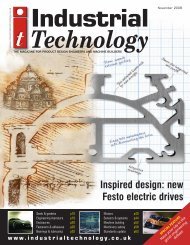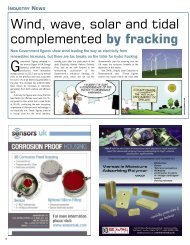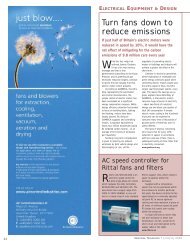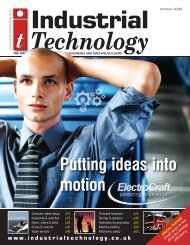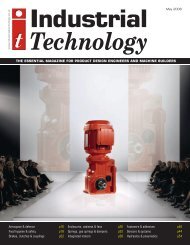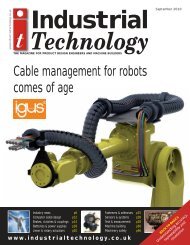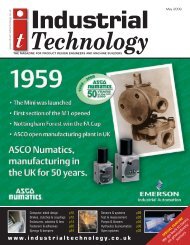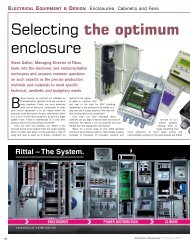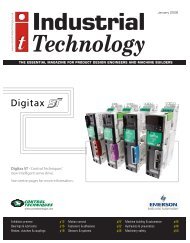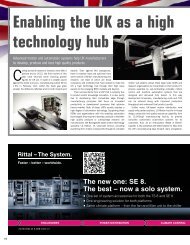machine building & automation - Industrial Technology Magazine
machine building & automation - Industrial Technology Magazine
machine building & automation - Industrial Technology Magazine
- No tags were found...
Create successful ePaper yourself
Turn your PDF publications into a flip-book with our unique Google optimized e-Paper software.
POWER TRANSMISSIONGears & Geared MotorsSophisticated separation<strong>machine</strong> designReliable drives for the food industry are proving key in anapplication to separate sinews and cartilage from meatHow to best puree fruit containing stones, or toseparate fish mince from fishbone? And howto remove sinew and gristle from meat withoutwasting material? Every amateur chef who hasalready spent hours pressing fruit through a sieve with aspoon or preparing chicken soup knows these questions.In the food industry, these methods have an automatedequivalent that makes time-consuming manual labourunnecessary: so-called soft separators are used to gentlyseparate the solid and soft components of a wide range ofbasic products. Robust, reliable drive technologycomponents that are suitable for the requirements of thefood industry are a key prerequisite for a consistently highproduct quality.The Baader group, a leading manufacturer of<strong>machine</strong>ry and processing plant for the food industry,developed suitable technology for the clean separation ofmeat and sinews or cartilage more than 40 years ago.Over time, the product range was extended, and nowincludes soft separators with varying performances thatcan be used to remove sinew from meat and poultry, torecover meat from fish, to extract pulp from fruit andvegetables, and to unpack food products. In Baader softseparators, a toothed chain powered by a geared motor isused to move a squeezing belt. The squeezing belttransports the product to a perforated drum and squeezesthe soft components through the perforation, while thesolid particles remain outside of the drum. An adjustablecylinder allows users to adjust the yield/quality ratio. Thismethod ensures maximum product quality andminimal temperatureincrease.Thus, the cellstructure of the source product is notdestroyed, since the squeezing belt systemoffers sufficient flexibility. At the sametime, unwanted solid componentsare kept out of the end productduring meat processing. Last but notleast, the method results inconsiderable time savings and astandardised final product comparedto manual product separation.Baader’s soft separators weredeveloped in the 1960s and havebeen constantly optimised sincethen, for example with regard to thecleaning options. They comply with internationallyrecognised hygiene standards. In several models, helicalbevel geared motors from Nord Drivesystems serve asdrive units. One example is the Baader 605 type, whichreaches a maximum performance of approximately3,000kg per hour depending on the hole size in theThe separation technology results inconsiderable time savings comparedto manual product separation,without destroying the cell structureof the source productperforated drum, the feeding type, the product, thefeeding temperature and the selected pressure – therebyqualifying for continuous large volume processing. Userscan choose a hole diameter of 1.3, 2, 3, 5 or 8mm in theperforated drum, with other diameters availableon request.Nord provides robust helical bevel gearmotors for the soft separators – Baader uses theSK 9016.1, SK 9022.1 and SK 9042.1 gearunit types. These drives owe their long lifeendurance partly to the Unicase design of Nord’sgeared motors: the housing, which is made from asingle-piece casting with integrated bearing seats,eliminates all sealing surfaces that could deflectunder the effect of torque or radial forces. The highefficiencygear units with durable, wear-free gearteeth also contribute to high reliability duringoperation. Nord’s consultation services for customersand users was another factor in the choice of a supplier.Nord has, for instance, also advised Baader during thepreparation of switching over to IE2 motors, helped byextensive experience in the development of efficientdrive technology and application-specific energy savingsconcepts. “In Nord, we have found a reliable, competentpartner who supplies us with customised drivesolutions,” explains Martin Schaarschmidt, sales managerfor separator technology at Baader. “Consultation throughNord experts in particular is a great relief, and allows usto focus completely on our own products.”Since June 2011, electric motors must fulfill thestricter energy efficiency requirements of the IE2efficiency class. Nord has been supplying IE2 motors forsome time. The company has implemented a three-pointconcept: compliance with the IE2 efficiency class isachieved firstly by the use of more active material,secondly by choosing higher quality sheet metal with lesslosses, and thirdly with increased copper filling incombination with a simultaneous reduction in the size ofthe windings. Nord IE2 motors offer various advantagesover previous models, including improved efficiency,higher start-up and breakdown torques, decreased slip,and less waste heat with better thermal performance.Compared to their direct predecessor models, IE2-typemotors thus offer an increased service life and help saveoperating costs. If required, the operating range, whichhas been shifted upwards towards a better efficiency, canbe used to continuously operate the new motors at a150% performance factor. Alternatively, users can nowchoose a smaller motor type for many applications.Nord also develops IE3 motors. These solutions mustensure an efficiency increase of at least 10% comparedwith the IE2 class. In many cases, this goal can beachieved through the three-point concept. For some IE3systems, Nord will also make use of different materials.Replacing aluminium with copper as the conductormaterial for the squirrel cage considerably reduces rotorlosses in IE3 systems. In addition to that, some furthermeasures can be useful in IE3 solutions, such as the useof sheet lamination material with lower specific corelosses, larger conductor cross-sections in the windings,flux-optimised windings, and smaller windings. Furtherincreases in efficiency can also be achieved withpermanent magnet motors and with frequency inverteroperation (synchronous motor principle).www.nord.com26INDUSTRIAL TECHNOLOGY • April 2012


